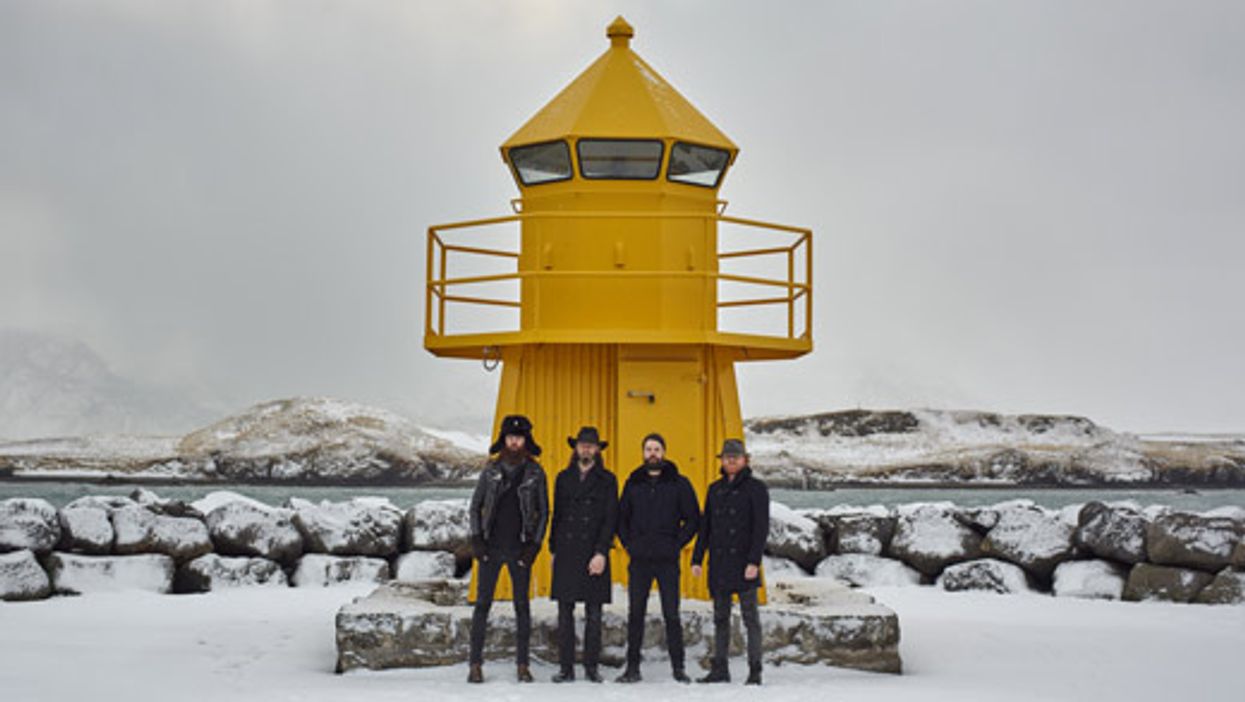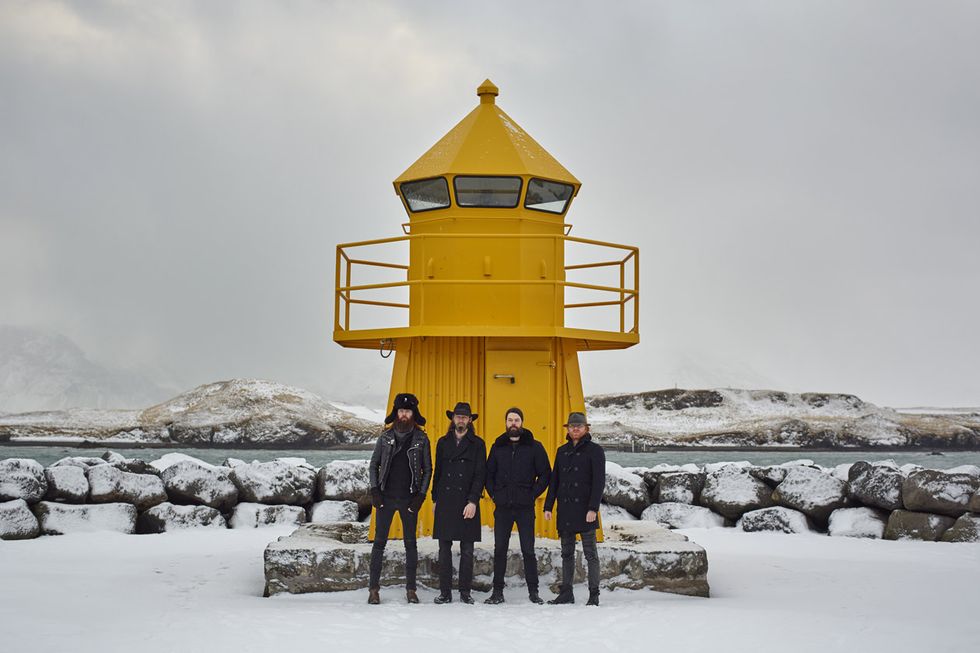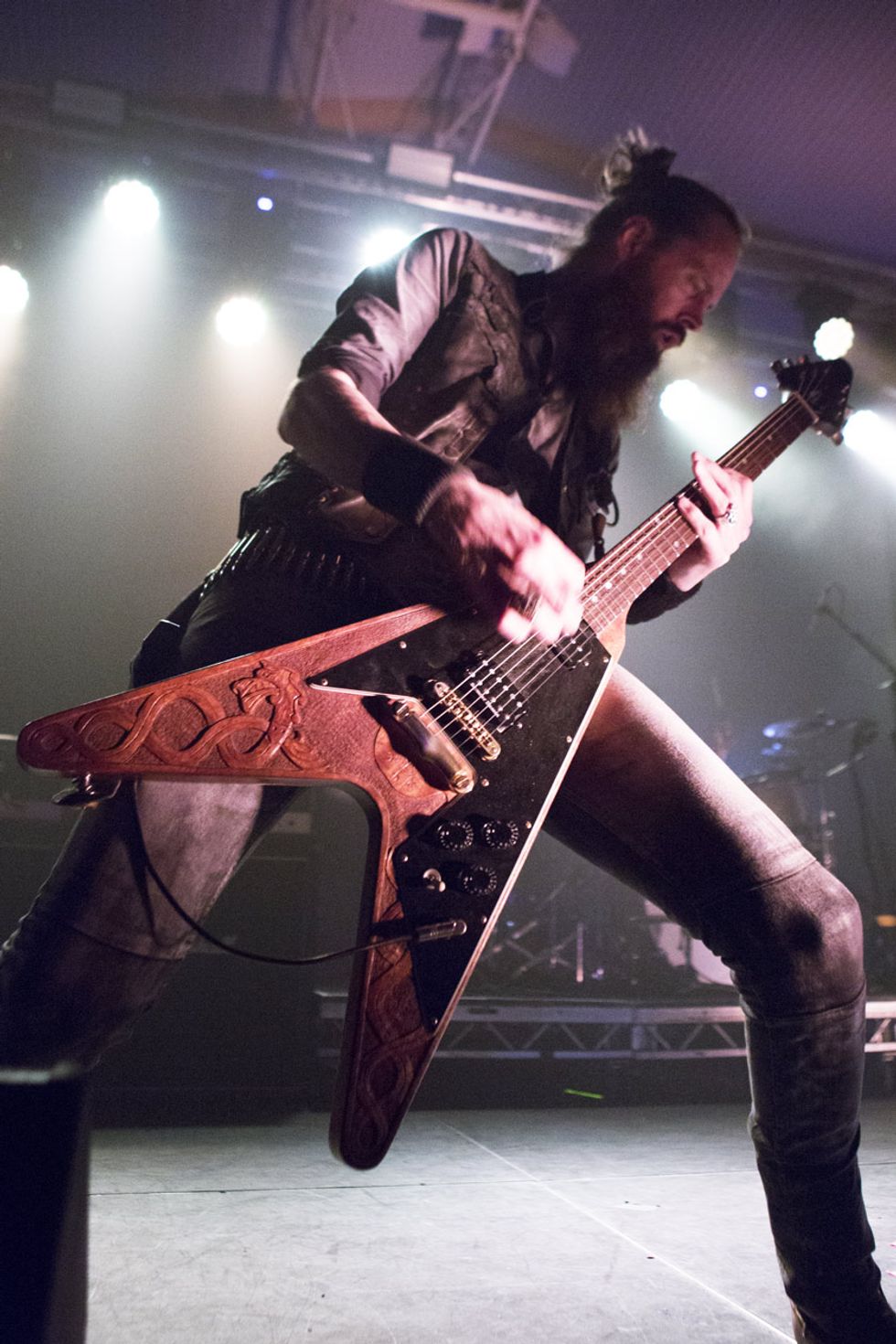Besides the music of Italian composer Ennio Morricone, the sound of Sólstafir (from left to right: singer-guitarist Addi Tryggvason, guitarist Pjúddi Sæþórsson, drummer Hallgrímur Jón Hallgrímsson, and bassist Svabbi Austmanngot)
is influenced by Iceland's desolate terrain. Photo by Snorri Sturluson
Compiling a list of Icelandic bands that have successfully broken through to the U.S. music scene is hardly an exhausting undertaking. In terms of household-name fame, you've pretty much got Björk and Sigur Rós (and even that is probably stretching it a bit). But the four members of Sólstafir have also been doing their damnedest for more than 20 years now—and they're doing so while holding fast to their Scandinavian heritage.
Comprised of singer-guitarist Aðalbjörn “Addi" Tryggvason, guitarist Sæþór Maríus “Pjúddi" Sæþórsson, bassist Svavar “Svabbi" Austmanngot, and drummer Hallgrímur Jón Hallgrímsson, Sólstafir got its start in the 1990s as one of the first black metal bands to gain notoriety back in Iceland. But while Tryggvason and company's love of, and immersion in, the black metal sound was on full display across their 2002 debut, Í Blóði og Anda (which translates as “In Blood and Spirit"), a careful listen would also foreshadow the sonic changes to come.
Those changes came in a flood on the band's sophomore outing, Masterpiece of Bitterness. They began delving into vast soundscapes such as the moody, sprawlingly epic 20-minute opening track, “I Myself the Visionary Head." And in the ensuing years, it became abundantly clear that the ever-evolving music of Sólstafir has much more in common with the aural paintings of film composers like Ennio Morricone than with the black metal of Immortal.
With the release of their most recent outing, Berdreyminn (which roughly translates as “A Dreamer of Future Events"),the band shows that—while they've retained their multifaceted signature sound—they have no intention of slowing their evolution. The atmospheric arrangements inspired by Iceland's unforgiving-yet-beautiful landscape are still on full display, but there are also more unexpected turns such as the lovely, almost Allman Brothers-esque harmonized leads and echo-laden bass break on “Ísafold," the forlorn vocal melodies and throbbing Wurlitzer piano of “Ambátt," and the somber church-organ intonations and clockwork riffing on “Bláfjall." Which is perhaps why Tryggvason is quick to caution, “People hear an album and they think that piece is the whole picture—but it's just a part of who we are." Following is our recent conversation with Tryggvason about how Berdreyminn serves as a majestic example of what drives him and his Sólstafir cohorts, as well as what the future may bring for the quartet.
You guys have been flying the flag for Icelandic music for a long time, and you still sing in Icelandic. Was it tough to decide to stick with that, knowing that singing in English might broaden your audience?
When we started playing black metal, it was all in English. Then we saw that [Norwegian black-metal band] Enslaved was singing in Gammelnorsk—Old Norwegian—which is the closest you can get to Icelandic. So we thought, “if those Norwegians are singing in Icelandic, we're going to do it as well!" And it's more personal and from the heart to sing in the language that you think in. It's unfiltered expression. We may go back to English later on. But we're very comfortable with Icelandic right now.
What types of subjects do your lyrics focus on?
Desperation through depression, y'know? Severe depression, alcoholism, drug addiction, and even domestic violence. Pretty much every member of this band has dealt with depression or addiction. So we don't have to travel far to get subjects.
Vastness, bleakness, and despair appear to have always played a big role in Sólstafir's identity. Why is that?
I think it's where you grow up. I don't think Black Sabbath would have sounded like Black Sabbath if they had come from Milan [Italy] or Saint Petersburg [Russia]. We grew up on a desolate island in the middle of fucking nowhere.
Can you talk about the influence of Ennio Morricone and spaghetti western soundtracks on your music?
Talking about Ennio Morricone is like talking about spirituality. If you watch the movie For a Few Dollars More, it's like Pulp Fiction—you can watch it while only listening to the score. I still think it is the coolest score ever written. It was made in 1965 and I think it is god-like. It's like reading Buddhism. There's endless quotes and endless influence you can get from Ennio Morricone.
There are a lot of similarities between those films and scores and your music and videos—particularly the wide-open spaces and the use of sound to paint pictures.
That is a really good way to put it.
How would you describe the band's musical growth from your last album, Ótta, to Berdreyminn?
I don't know, man. Musical growth is between the ages of 12 and 18. That's your growth. Between 41 and 44? Not so much growth, really [laughs]—just a few more gray hairs. We still have pianos, synths, and strings. We still have screaming vocals and soft vocals. We still have full-blown heavy metal guitars and distorted bass. So, I don't know how I can describe the growth. It's just our new album. To me, we always sound the bloody same. To me, our sound isn't a little hole—it's a whole fucking horizon. So when people just grab onto a little hole, that's just a little piece of the puzzle.
Tryggvason's guitar named the Eagle was made by Icelandic builder Gunnar Orn and its body was then finished by a professional wood carver. It has accompanied its owner on at least 500 gigs, including this one at
Iceland's Eistnaflug metal fest.Photo by Falk-Hagen Bernshausen
And yet, as expansive as the band's sound is, you, Pjúddi, and Svabbi seem to prefer stripped-down, vintage-style guitar tones.
I think it's mostly trying to have a timeless sound. I don't want people to be able to say, “This was definitely done in the era where everybody used the new Mesa/Boogie with a new EMG pickups in a new ESP guitar." I like having a guitar tone that I can play a Neil Young riff on and I can play a Slayer riff on. I don't like clean sounds. So I'll have just enough gain so I can play some chords and I can do a riff. And we really wanted to have a very classic drum sound. Not too much EQ, there's no editing. It's just a classic sound.
Do you guys track live in the studio to get that feel?
I should tell you a story like Guns N' Roses' Appetite for Destruction, where they went into the studio and, “one, two, three, four!" and that's what you hear. But it's not really like that. We just start with a good drum track and bass. Then we bake the cake on top of that.
Yet you're able to maintain a very raw and natural sound.
Overproduced is not really our cup of tea.
What guitar amps did you use to track Berdreyminn?
It's an Orange Thunderverb 200. This is the first album where we used Orange. We tracked almost the entire album with it—I'd say 90 percent. I like the Thunderverb because it has two master-volume channels. I need two channels with volume and gain controls because I use the EBow [Heet Sound's electronic infinite sustainer]. My clean channel is my EBow channel, and I need to be able to have gain and volume on it.
Your EBow use has become a signature that adds a lot of ambiance to the Sólstafir sound. What inspired that?
I think it was 2004, when I sold my first apartment and came across a little bit of money. I bought most of the pedals that I still use today and an EBow, because some friends of mine had been using it. I first used it on the Masterpiece of Bitterness album, and I've gotten pretty confident with it. There's no gig without the EBow these days.
Aðalbjörn Tryggvason's Gear
GuitarsOrn Custom Guitars Eagle V
2003 Gibson Flying V
Deering Goodtime 4-string banjo
Amps
Orange Thunderverb 200 with stock tubes
Orange 4x12 cab
Effects
Heet Sound EBow
Boss OC-3 Super Octave
Boss RV-5 Reverb
Boss DD-3 Digital Delay
TC Electronic Hall of Fame Reverb
Strings and Picks
Dunlop .010–.052 sets with .056 or .058 bottom string
Dunlop .88 mm Tortex picks
Boss TU-2 tuner
Do you guys like to experiment with effects live and in the studio?
I'm like a dinosaur—I have a Boss DD-3, I have the Boss reverb, I have a Boss octave, and I have a Boss tuner. All the old stuff. I have a [TC Electronic] Hall of Fame Reverb, as well. So I have two reverbs, but I don't use the effects loop. I'm pretty simple. I pretty much just use reverb, delay, and the amp drive.
What's the story behind the carved V-shaped guitar you're often seen with?
For years I was searching for a guy that would carve into my Gibson V, because I saw Lemmy [Kilmister]'s Rickenbacker—it just looked so amazing! But I never found him. Then this guitar maker in Iceland [Gunnar Orn] wanted to make a V that he gave to me. His friend was a professional wood carver who had exhibitions in Japan and stuff. It was a dream I had for 10 to 15 years. We call it the Eagle. I've probably done 500 gigs with that guitar. I can't afford to bring multiple guitars for a single festival, but when we tour I'll bring spare guitars. But most of the songs I'm only playing the one guitar.
Do you record with that guitar exclusively?
On this album, I used only the Eagle guitar. I've always used different guitars for different parts, but this time I just said, “Fuck it."
With you shifting musical styles, has your fan base changed over the years?
It has changed significantly. We can be playing a brutal metal festival in the Czech Republic, then we go to the Netherlands to play a family-oriented festival. It's completely different audiences. Our songs work for both. Before it was mostly German male black-metal fans in their early 20s. Now it's from 60-year-old Deep Purple fans down to 18-year-old girls.
Why do you think a band as unique-sounding as yours and that sings in a language not many people understand has been able to garner the success and longevity you guys have?
When we started the band, we thought we probably wouldn't get signed and were never going to play live, because nobody would show up. We never got to be the flavor of the week, month, year, or decade. But we've never declined—we've always been on a very slow and steady rise. But we have had our obstacles. We could write a book about that. But we've survived it. Maybe it's just because we like making music together, and that's the only reason we're still here.
YouTube It
Sólstafir's willingness to experiment with instruments and techniques, such as banjo and EBow, are on full display in this in-studio performance of the title track off their 2014 album, Ótta.














![Rig Rundown: Russian Circles’ Mike Sullivan [2025]](https://www.premierguitar.com/media-library/youtube.jpg?id=62303631&width=1245&height=700&quality=70&coordinates=0%2C0%2C0%2C0)












![Rig Rundown: AFI [2025]](https://www.premierguitar.com/media-library/youtube.jpg?id=62064741&width=1245&height=700&quality=70&coordinates=0%2C0%2C0%2C0)




















 Zach loves his Sovtek Mig 60 head, which he plays through a cab he built himself at a pipe-organ shop in Denver. Every glue joint is lined with thin leather for maximum air tightness, and it’s stocked with Celestion G12M Greenback speakers.
Zach loves his Sovtek Mig 60 head, which he plays through a cab he built himself at a pipe-organ shop in Denver. Every glue joint is lined with thin leather for maximum air tightness, and it’s stocked with Celestion G12M Greenback speakers.











